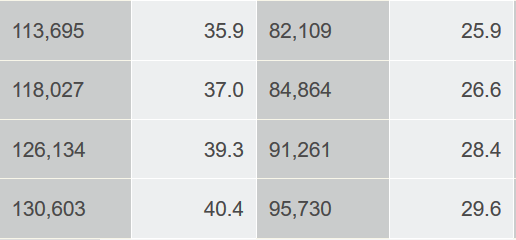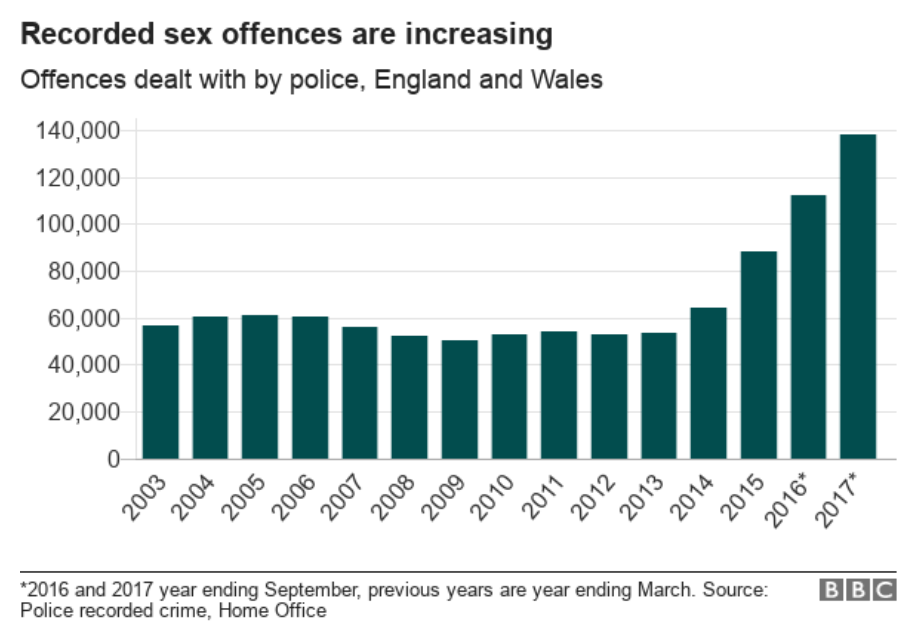RAPE RATES UPDATE: Please see this more recent, far more extensive article on rape rates addressing the claim that widespread porn use has resulted in a decrease in the rates of sexual offending: Debunking the realyourbrainonporn (pornographyresearch.com) “Sex Offender Section”: The actual state of the research on porn use and sexual aggression, coercion & violence
———————————-
Porn use does not reduce rape rates
Have you heard the often repeated claim (by porn sites and sexologists) that “porn use dramatically lowers rape rates?” It’s wrong.
According to new statistics released by the FBI (excerpt below), the number of rapes (per 100,000 of the population) has steadily increased from 2014-2016 (the last year for which stats are available). In the UK, there were 138,045 sex offenses, up 23%, in the 12 months preceding September, 2017.
Yet, during those same periods:
- the population has continued to age, and
- overall rates of sexual activity have steadily dropped, as have fertility rates in the West.
Internet porn use is nearly universal among young men. In fact, many young men seem glued to porn on their screens and uninterested in real life encounters…and yet rapes are rising. So is evidence of aggressive behavior in porn users (generally). The recent meta-study entitled “A Meta‐Analysis of Pornography Consumption and Actual Acts of Sexual Aggression in General Population Studies” reported that:
22 studies from 7 different countries were analyzed. [Porn] Consumption was associated with sexual aggression in the United States and internationally, among males and females, and in cross‐sectional and longitudinal studies. Associations were stronger for verbal than physical sexual aggression, although both were significant. The general pattern of results suggested that violent content may be an exacerbating factor.
FBI Statistics
Turning back to the newly available FBI statistics, look at the last 4 years in this table (excerpt pictured below). Number of rapes and rape rates per 100,000 begin about half way across the page. You will see rates using the FBI’s revised definition of rape, and rates using its former definition. Rates are rising using both definitions. Here’s a screenshot of the key information. The top row of numbers are from 2013 and the bottom is from 2016.

According to the FBI,
There were an estimated 95,730 rapes (legacy definition) reported to law enforcement in 2016. This estimate was 4.9 percent higher than the 2015 estimate, 12.4 percent higher than the 2012 estimate, and 3.9 percent higher than the 2007 estimate. (See Tables 1 and 1A.)
UK Rape rates
The trend appears to be continuing, based on stats from the UK (pictured above in this post).
It’s always well to keep in mind that the crime of rape is consistently under-reported. Even reports to police may be wildly off, as this paper by a US law professor suggests: How to Lie with Rape Statistics: America’s Hidden Rape Crisis (2014).
This study addresses how widespread the practice of undercounting rape is in police departments across the country. Because identifying fraudulent and incorrect data is essentially the task of distinguishing highly unusual data patterns, I apply a statistical outlier detection technique to determine which jurisdictions have substantial anomalies in their data. Using this novel method to determine if other municipalities likely failed to report the true number of rape complaints made, I find significant undercounting of rape incidents by police departments across the country. The results indicate that approximately 22% of the 210 studied police departments responsible for populations of at least 100,000 persons have substantial statistical irregularities in their rape data indicating considerable undercounting from 1995 to 2012.
Notably, the number of undercounting jurisdictions has increased by over 61% during the eighteen years studied. Correcting the data to remove police undercounting by imputing data from highly correlated murder rates, the study conservatively estimates that 796,213 to 1,145,309 complaints of forcible vaginal rapes of female victims nationwide disappeared from the official records from 1995 to 2012. Further, the corrected data reveal that the study period includes fifteen to eighteen of the highest rates of rape since tracking of the data began in 1930. Instead of experiencing the widely reported “great decline” in rape, America is in the midst of a hidden rape crisis.
Porn use affects belief
Finally, the vast preponderance of research demonstrates that porn use affects beliefs, attitudes and behaviors. Check out individual studies – over 25 studies link porn use to “un-egalitarian attitudes” toward women and sexist views – or this summary from this 2016 meta-analysis: Media and Sexualization: State of Empirical Research, 1995–2015. Excerpt:
The goal of this review was to synthesize empirical investigations testing effects of media sexualization. The focus was on research published in peer-reviewed, English-language journals between 1995 and 2015. A total of 109 publications that contained 135 studies were reviewed. The findings provided consistent evidence that both laboratory exposure and regular, everyday exposure to this content are directly associated with a range of consequences, including higher levels of body dissatisfaction, greater self-objectification, greater support of sexist beliefs and of adversarial sexual beliefs, and greater tolerance of sexual violence toward women. Moreover, experimental exposure to this content leads both women and men to have a diminished view of women’s competence, morality, and humanity.
